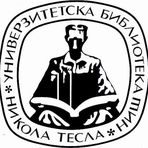Title
Sinteza, karakterizacija i primena hidrogelova na bazi N-izopropilakrilamida i anjonskih komonomera za uklanjanje hroma, mangana i olova iz vodenih rastvora
Creator
Zdravković, Aleksandar 1987-
Copyright date
2019
Object Links
Select license
Autorstvo-Nekomercijalno-Bez prerade 3.0 Srbija (CC BY-NC-ND 3.0)
License description
Dozvoljavate samo preuzimanje i distribuciju dela, ako/dok se pravilno naznačava ime autora, bez ikakvih promena dela i bez prava komercijalnog korišćenja dela. Ova licenca je najstroža CC licenca. Osnovni opis Licence: http://creativecommons.org/licenses/by-nc-nd/3.0/rs/deed.sr_LATN. Sadržaj ugovora u celini: http://creativecommons.org/licenses/by-nc-nd/3.0/rs/legalcode.sr-Latn
Language
Serbian
Cobiss-ID
Theses Type
Doktorska disertacija
description
Datum odbrane: 24.09.2019.
Other responsibilities
mentor
Nikolić, Ljubiša 1963-
član komisije
Džunuzović, Enis 1971-
predsednik komisije
Cakić, Suzana 1967-
član komisije
Nikolić, Vesna 1965-
Academic Expertise
Tehničko-tehnološke nauke
University
Univerzitet u Nišu
Faculty
Tehnološki fakultet
Group
Katedra za hemijske nauke
Alternative title
Synthesis, characterization and application of hydrogels based on N-isopropylacrylamide and anionic comonomers for chromium, manganese and lead removal from aqueous solutions
Publisher
[A. S. Zdravković]
Format
[12], 149 listova
description
Biografija autora: list 139;
Bibliografija: listovi 140-146.
description
Chemistry and chemical technology
Abstract (en)
In this doctoral dissertation, the hydrogels sensitive to temperature and pH
changes based on N-isopropylacrylamide (NIPAM) and anionic
comonomers (acrylic acid, AA, and methacrylic acid, MAA) were
synthesized and investigated as adsorbent materials for removal of Cr(VI),
Mn(II) and Pb(II) ions from aqueous solutions.
The hydrogels were synthesized by radical polymerization process by
varying the content of comonomer and crosslinker. The obtained poly(Nisopropylacrylamide-
co-acrylic acid) (p(NIPAM/AA)) and poly(Nisopropylacrylamide-
co-methacrylic acid) (p(NIPAM/MAA)) hydrogels
were characterized using the following methods: Fourier transform
infrared spectroscopy (FTIR), scanning electron microscopy (SEM),
X-ray diffraction (XRD), high pressure liquid chromatography (HPLC)
and determining the swelling intensity in aqueous solutions of different
temperatures and pH values. Kinetics of hydrogel swelling before and
after the lyophilization process, as well as swelling reversibility through 3
alternate swell-shrink cycles under the influence of temperature were
investigated. A full three-level experimental design was applied in order
to describe the swelling of synthesized hydrogels as a function of
temperature, pH value and crosslinker content by a mathematical model.
Characterization of p(NIPAM/AA) and p(NIPAM/MAA) hydrogels with
adsorbed metal ions was performed by FTIR and SEM method. Heavy
metal ions in the structure of hydrogels were identified by energydispersive
X-ray spectroscopy (EDX). The influence of pH, temperature,
contact time and initial concentration of heavy metals on adsorption
capacity of hydrogels was investigated.
The kinetic and equilibrium data match best to the pseudo-second order
model and Langmuir adsorption isotherm. Based on the thermodynamic
results, it has been concluded that the adsorption of Cr(VI), Mn(II) and
Pb(II) ions from aqueous solutions onto hydrogels was spontaneous and
exothermic process.
The adsorption capacity of p(NIPAM/AA) and p(NIPAM/MAA)
hydrogels for investigated metal ions decreases in the following order:
Pb(II)>Cr(VI)>Mn(II).
Hydrogels based on NIPAM and AA or MAA are considered to be
suitable adsorbents for removal of Cr(VI), Mn(II) and Pb(II) ions from
aqueous solutions, due to high efficiency in the temperature range from 25
to 45 °C.
Authors Key words
hidrogel, bubrenje, difuzija, adsorpcija, teški metal, kinetika
Authors Key words
hydrogel, swelling, diffusion, adsorption, heavy metal, kinetics
Classification
544.773.432:66.095.26]:502/504(043.3)
Subject
T 390
Type
Tekst
Abstract (en)
In this doctoral dissertation, the hydrogels sensitive to temperature and pH
changes based on N-isopropylacrylamide (NIPAM) and anionic
comonomers (acrylic acid, AA, and methacrylic acid, MAA) were
synthesized and investigated as adsorbent materials for removal of Cr(VI),
Mn(II) and Pb(II) ions from aqueous solutions.
The hydrogels were synthesized by radical polymerization process by
varying the content of comonomer and crosslinker. The obtained poly(Nisopropylacrylamide-
co-acrylic acid) (p(NIPAM/AA)) and poly(Nisopropylacrylamide-
co-methacrylic acid) (p(NIPAM/MAA)) hydrogels
were characterized using the following methods: Fourier transform
infrared spectroscopy (FTIR), scanning electron microscopy (SEM),
X-ray diffraction (XRD), high pressure liquid chromatography (HPLC)
and determining the swelling intensity in aqueous solutions of different
temperatures and pH values. Kinetics of hydrogel swelling before and
after the lyophilization process, as well as swelling reversibility through 3
alternate swell-shrink cycles under the influence of temperature were
investigated. A full three-level experimental design was applied in order
to describe the swelling of synthesized hydrogels as a function of
temperature, pH value and crosslinker content by a mathematical model.
Characterization of p(NIPAM/AA) and p(NIPAM/MAA) hydrogels with
adsorbed metal ions was performed by FTIR and SEM method. Heavy
metal ions in the structure of hydrogels were identified by energydispersive
X-ray spectroscopy (EDX). The influence of pH, temperature,
contact time and initial concentration of heavy metals on adsorption
capacity of hydrogels was investigated.
The kinetic and equilibrium data match best to the pseudo-second order
model and Langmuir adsorption isotherm. Based on the thermodynamic
results, it has been concluded that the adsorption of Cr(VI), Mn(II) and
Pb(II) ions from aqueous solutions onto hydrogels was spontaneous and
exothermic process.
The adsorption capacity of p(NIPAM/AA) and p(NIPAM/MAA)
hydrogels for investigated metal ions decreases in the following order:
Pb(II)>Cr(VI)>Mn(II).
Hydrogels based on NIPAM and AA or MAA are considered to be
suitable adsorbents for removal of Cr(VI), Mn(II) and Pb(II) ions from
aqueous solutions, due to high efficiency in the temperature range from 25
to 45 °C.
“Data exchange” service offers individual users metadata transfer in several different formats. Citation formats are offered for transfers in texts as for the transfer into internet pages. Citation formats include permanent links that guarantee access to cited sources. For use are commonly structured metadata schemes : Dublin Core xml and ETUB-MS xml, local adaptation of international ETD-MS scheme intended for use in academic documents.


